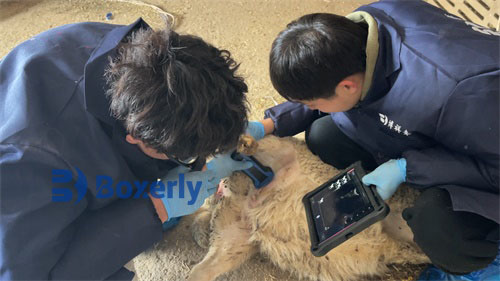Follicles are located in the ovarian reproductive epithelium and are a special structure that wraps around the oocyte. The ovaries of various animals have slight differences. Before birth, animals have a large number of primordial follicles on their ovaries, which gradually decrease with age after birth. Most follicles lock and die midway, while a few mature and ovulate. During each estrus cycle, there are dozens of follicles that can develop, but only one mature follicle. More than 91% of cows ovulate only one follicle per estrus cycle.
Follicle development refers to the process in which follicles develop from primordial follicles to primary follicles, and then to secondary follicles, tertiary follicles, and Graves' follicles. After the onset of puberty, the primordial follicles on the ovaries undergo a series of developmental stages and eventually mature and ovulate. Therefore, according to different developmental stages, follicles can be divided into primordial follicles, primary follicles, secondary follicles, growing follicles (tertiary follicles), and mature follicles (Graves' follicles), with most follicles degenerating during development
Primary follicle: A primary follicle is a follicle located in the cortex of the ovary, consisting of an oocyte and a layer of cuboidal follicular cells arranged around it. It develops from the primordial follicle, with an undeveloped follicular membrane and no cavity.
Secondary follicle: further developed from primary follicles, located in deeper layers of the ovarian cortex. Primary follicles consist of 2 to 4 layers of follicular cells surrounding the oocyte. Its characteristics are that both the follicular cell membrane and the oocyte are larger than those of primary stage follicles. As the follicle develops, the fluid secreted by the follicular cells increases, causing the gap between the follicular cells and the oocyte cell membrane to widen, but still without forming a follicular cavity. The common feature of the above three types of follicles is the absence of a follicular cavity, and they are collectively referred to as antral free follicles or preantral follicles.
Tertiary follicle: Secondary follicles further develop into tertiary follicles. During this period, the fluid secreted by the follicular cell membrane enters the interstitial space of the oocyte, forming the follicular cavity. As the secretion of fluid increases, the follicular cavity further expands, and the oocyte membrane is squeezed to one side and wrapped in a cluster of follicular cell membranes, forming a peninsula protruding from the follicular cavity, called a cumulus. The remaining follicular cells are tightly attached to the periphery of the follicular cavity, forming a granulosa cell membrane layer.
The timing of follicular cavity formation is related to the degree of follicular development. Follicles with faster development have earlier follicular cavity formation, while follicles with slower development have later follicular cavity formation. The growth of antral follicles does not depend on Gn RH; The formation of follicular cavity and the growth of antral follicles depend on Gn RH. Therefore, whether the follicular cavity is formed and its size after formation can be used as a basis for evaluating the degree of follicular development. Usually, the size of the follicular cavity is not necessarily proportional to the size of the follicle.
Graves' follicle: The tertiary follicle further develops into Graves' follicle (discovered by Regnier de Graaf in 1672). Follicles further develop into pre mature follicles. This type of follicle expansion can reach the entire thickness of the ovarian cortex, even protruding from the surface of the ovary, and the periphery of the follicle granules is enveloped by the follicular membrane. The follicular membrane is divided into two layers, with fibrous stromal cells on the outer membrane and numerous blood vessels distributed on the inner membrane. Endometrial cells participate in estrogen synthesis.
Mature follicle: When the follicle develops to a large volume, the follicle wall becomes thinner, and the volume increases to a large volume when the follicle cavity is filled with fluid. At this point, the follicle is called a mature follicle. The common characteristics of primary follicles, secondary follicles, and tertiary follicles are rapid growth and development, showing rapid cell membrane division and significant volume increase. Therefore, these three types of follicles are often referred to as growing follicles. There are many follicles on the ovary, each with equal developmental potential, manifested as increased volume and increased estrogen secretion. But only one follicle develops and matures during each estrus cycle. Advantageous follicles sometimes do not necessarily rupture and ovulate. By the time the estrus symptoms disappear, the follicles have matured and reached a volume of * * *. When female animals reach a certain stage of growth, their ovaries begin to move, and under the action of estrogen, the animals begin to heat up. Female animals generally begin to grow estrus follicles on their ovaries 3-4 days before the onset of estrus. Follicles rapidly develop 2-3 days before estrus, with endometrial hyperplasia, increased follicular fluid, increased follicular volume, thinner follicular walls, and some protruding from the ovarian surface. By the time the estrus symptoms disappear, the follicles have matured and their volume has reached * * *. Dr. Chen Jingbo's research shows that there is a negative correlation between large and small follicles on the ovary, with one large follicle accounting for 59.82%, two large follicles accounting for 30.86%, and no large follicles accounting for 9.82%. The distribution of follicles in cows during pregnancy is stable.
Follicle development involves the process of primary follicle, primary follicle, secondary follicle, tertiary follicle, and mature follicle or Graafian follicle. A complete mature follicle consists of the outer membrane, inner membrane, basement membrane, granulosa layer, cumulus oocyte complex, follicular cavity, and follicular fluid.
Follicle atresia and degeneration: Follicle atresia is a common phenomenon that occurs at various stages of follicle development. The closure of follicles is achieved through a special mode of cell death, namely apoptosis, which is the phenomenon of cell suicide in physiological states. The period of excessive follicular depletion is before birth and less after birth, mainly before the onset of puberty, and relatively small in adulthood. At 110 days of pregnancy, female fetuses of cows have 2.7 million oocytes, which decrease to 68000 at birth. As they age, most follicles undergo atresia and degeneration, and the degeneration and atresia of ovarian follicles occur in several generations approaching maturity.
The atresia and degeneration of follicles include a series of morphological changes in follicular cells and oocytes. The first thing seen in follicular atresia is the disintegration of cells. The nucleus of granulosa cells undergoes condensation, chromosomes form unstructured blocks, the nuclear membrane wrinkles, granulosa cells detach from the original granulosa layer and suspend in follicular fluid, cumulus cells decompose, and oocytes undergo abnormal division
Thickening of the zona pellucida, cell fragmentation, and other changes lead to the closure of follicles surrounded by fibrocytes in the ovary, resulting in the disappearance of follicles and the formation of scars. The atresia and degeneration of follicles are regulated by multiple factors.









